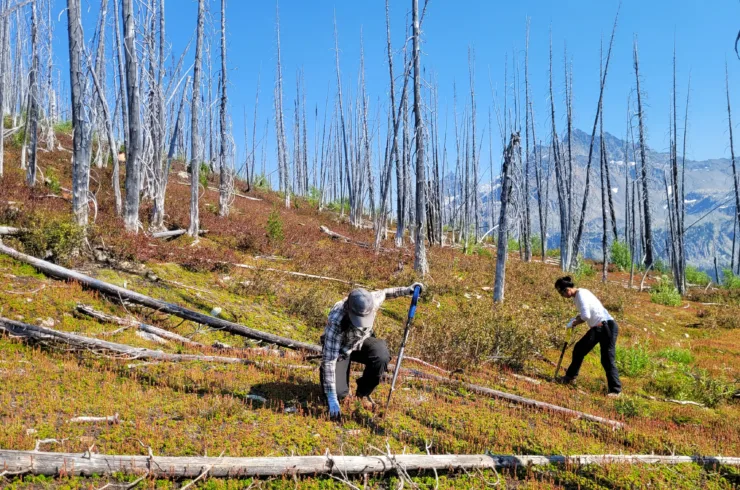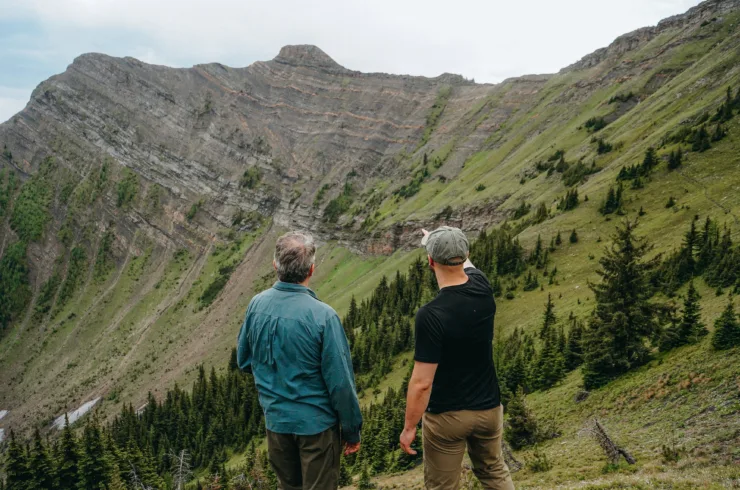As we manoeuvred through the felled trees, the huge stumps and coarse branches treacherous underfoot, the first thing that struck me about the clearcut was the heat; we were baking under the direct glare of the sun.
Stepping out of the clearcut’s heat and into the cool cover of the surrounding forest was a welcome relief — and a stark contrast. As we navigated through the spiked Devil’s Club, Wildsight Conservation Specialist Eddie Petryshen explained how the fellers wrap car straps around the bigger cedars to stop the trees splitting on impact when they hit the ground. Making our way deeper into the adjacent stand, it wasn’t long until we spotted car straps around large cedars, some over 2 metres in diameter, and the reality hit me in the chest: these ancient trees, some likely over 600 years old, would soon be gone.
This was my first visit to a cutblock since beginning my work with Wildsight’s Conservation team earlier this year. We had driven up from Revelstoke the day before, camping along the lake, and getting into the Redrock area just north of Mica Dam in the morning.
Working in the conservation space, I’m constantly learning about the environmental losses occurring around us. But seeing a fresh clearcut, and old and ancient stands of forest that would soon become one, in person hit differently.
It was heartbreaking to look at centuries worth of growth, an ancient ecosystem, lined up to be destroyed in a single afternoon. We were probably among the last people to see that forest the way it had stood for hundreds of years — to bear witness to the lives of some of British Columbia’s Inland Temperate Rainforest giants.

From above the contrast between Stella Jones’ clearcut and the remaining ancient forest is striking. If you look closely, you can see Eddie for scale. Once logged, we lose upwards of 80 percent of the carbon stored in these forests . The forest also loses much of its ability to stabilize the slope or filter and slow the course of snowmelt and rainwater runoff. This in turn means less water is absorbed into the earth, and more sediment winds up in our waterways. Photo: Reanne Harvey

The inconsistencies of logging and old-growth protection in B.C.’s Inland Temperate Rainforest: In the centre, recently clearcut old-growth forest; to the right, a 7-year-old clearcut; above, a clearcut from 30-40 years ago; below, an old-growth deferral area that is protected from logging, yet was still able to be legally cleared and fragmented for a road; and, to the left, more old growth soon to be cleared. Photo: Reanne Harvey

Wildsight Conservation Specialist Eddie Petryshen sits on the stump of a felled cedar tree estimated to have been at least 400 years old. Aging ancient cedar trees like this can be difficult because their cores decay and rot over time (a natural and healthy part of the aging process) making it difficult to count the oldest growth rings. Photo: Bailey Repp

It can be hard to comprehend the scale of these ancient trees, both in width and height. In this photo of a felled cedar, you can see the core decay that makes old-growth trees harder to age. Cedars can exist for centuries like this; the openings that appear at their bases provide perfect dens for grizzly bears. Photo: Bailey Repp

Fellers wrap car straps around ancient cedars to try to prevent them from shattering upon impact with the ground when they’re cut down due to their decayed cores. Often this doesn’t work, and the tree ends up in splinters. Photo: Bailey Repp

It was heartbreaking to think we were some of the last people to see this ancient forest — a forest that has existed in this same way for hundreds if not thousands of years, the moisture-rich environment helping it avoid disturbances like wildfires. Photo: Bailey Repp

Saying goodbye. Photo: Bailey Repp
Seeing this destruction, I can’t help but ask: knowing what we do about the significance of this ecosystem — its importance for drinking water, mountain caribou, clean air, carbon storage and so much more — why are we still letting this happen?
B.C.’s Inland Temperate Rainforest is one of the rarest rainforests on Earth; its old and ancient forests need to be protected. Take 2 minutes today to add your voice to the campaign for protection by sending a message to decision makers using our online letter-writing tool.










